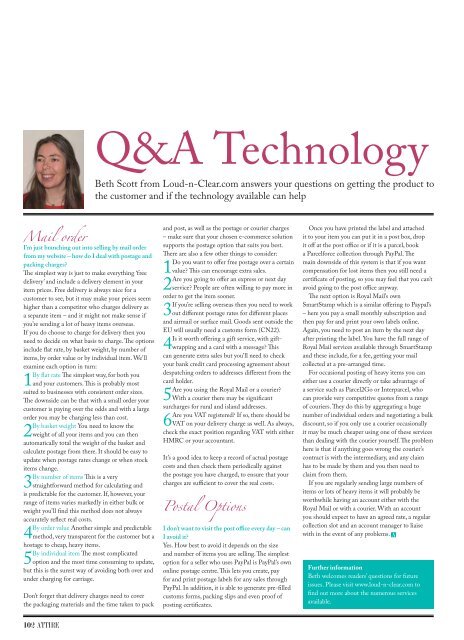Low-resolution PDF (11Mb) - Attire Accessories magazine
Low-resolution PDF (11Mb) - Attire Accessories magazine
Low-resolution PDF (11Mb) - Attire Accessories magazine
Create successful ePaper yourself
Turn your PDF publications into a flip-book with our unique Google optimized e-Paper software.
����������<br />
I’m just branching out into selling by mail order<br />
from my website – how do I deal with postage and<br />
packing charges?<br />
The simplest way is just to make everything ‘free<br />
delivery’ and include a delivery element in your<br />
item prices. Free delivery is always nice for a<br />
customer to see, but it may make your prices seem<br />
higher than a competitor who charges delivery as<br />
a separate item – and it might not make sense if<br />
you’re sending a lot of heavy items overseas.<br />
If you do choose to charge for delivery then you<br />
need to decide on what basis to charge. The options<br />
include flat rate, by basket weight, by number of<br />
items, by order value or by individual item. We’ll<br />
examine each option in turn:<br />
1By flat rate The simplest way, for both you<br />
and your customers. This is probably most<br />
suited to businesses with consistent order sizes.<br />
The downside can be that with a small order your<br />
customer is paying over the odds and with a large<br />
order you may be charging less than cost.<br />
By basket weight You need to know the<br />
2 weight of all your items and you can then<br />
automatically total the weight of the basket and<br />
calculate postage from there. It should be easy to<br />
update when postage rates change or when stock<br />
items change.<br />
By number of items This is a very<br />
3 straightforward method for calculating and<br />
is predictable for the customer. If, however, your<br />
range of items varies markedly in either bulk or<br />
weight you’ll find this method does not always<br />
accurately reflect real costs.<br />
By order value Another simple and predictable<br />
4 method, very transparent for the customer but a<br />
hostage to cheap, heavy items.<br />
By individual item The most complicated<br />
5 option and the most time consuming to update,<br />
but this is the surest way of avoiding both over and<br />
under charging for carriage.<br />
Don’t forget that delivery charges need to cover<br />
the packaging materials and the time taken to pack<br />
����������<br />
Q&A Technology<br />
Beth Scott from Loud-n-Clear.com answers your questions on getting the product to<br />
the customer and if the technology available can help<br />
and post, as well as the postage or courier charges<br />
– make sure that your chosen e-commerce solution<br />
supports the postage option that suits you best.<br />
There are also a few other things to consider:<br />
Do you want to offer free postage over a certain<br />
1 value? This can encourage extra sales.<br />
Are you going to offer an express or next day<br />
2 service? People are often willing to pay more in<br />
order to get the item sooner.<br />
If you’re selling overseas then you need to work<br />
3 out different postage rates for different places<br />
and airmail or surface mail. Goods sent outside the<br />
EU will usually need a customs form (CN22).<br />
Is it worth offering a gift service, with gift-<br />
4 wrapping and a card with a message? This<br />
can generate extra sales but you’ll need to check<br />
your bank credit card processing agreement about<br />
despatching orders to addresses different from the<br />
card holder.<br />
Are you using the Royal Mail or a courier?<br />
5 With a courier there may be significant<br />
surcharges for rural and island addresses.<br />
Are you VAT registered? If so, there should be<br />
6 VAT on your delivery charge as well. As always,<br />
check the exact position regarding VAT with either<br />
HMRC or your accountant.<br />
It’s a good idea to keep a record of actual postage<br />
costs and then check them periodically against<br />
the postage you have charged, to ensure that your<br />
charges are sufficient to cover the real costs.<br />
��������������<br />
I don’t want to visit the post office every day – can<br />
I avoid it?<br />
Yes. How best to avoid it depends on the size<br />
and number of items you are selling. The simplest<br />
option for a seller who uses PayPal is PayPal’s own<br />
online postage centre. This lets you create, pay<br />
for and print postage labels for any sales through<br />
PayPal. In addition, it is able to generate pre-filled<br />
customs forms, packing slips and even proof of<br />
posting certificates.<br />
Once you have printed the label and attached<br />
it to your item you can put it in a post box, drop<br />
it off at the post office or if it is a parcel, book<br />
a Parcelforce collection through PayPal. The<br />
main downside of this system is that if you want<br />
compensation for lost items then you still need a<br />
certificate of posting, so you may feel that you can’t<br />
avoid going to the post office anyway.<br />
The next option is Royal Mail’s own<br />
SmartStamp which is a similar offering to Paypal’s<br />
– here you pay a small monthly subscription and<br />
then pay for and print your own labels online.<br />
Again, you need to post an item by the next day<br />
after printing the label. You have the full range of<br />
Royal Mail services available through SmartStamp<br />
and these include, for a fee, getting your mail<br />
collected at a pre-arranged time.<br />
For occasional posting of heavy items you can<br />
either use a courier directly or take advantage of<br />
a service such as Parcel2Go or Interparcel, who<br />
can provide very competitive quotes from a range<br />
of couriers. They do this by aggregating a huge<br />
number of individual orders and negotiating a bulk<br />
discount, so if you only use a courier occasionally<br />
it may be much cheaper using one of these services<br />
than dealing with the courier yourself. The problem<br />
here is that if anything goes wrong the courier’s<br />
contract is with the intermediary, and any claim<br />
has to be made by them and you then need to<br />
claim from them.<br />
If you are regularly sending large numbers of<br />
items or lots of heavy items it will probably be<br />
worthwhile having an account either with the<br />
Royal Mail or with a courier. With an account<br />
you should expect to have an agreed rate, a regular<br />
collection slot and an account manager to liaise<br />
with in the event of any problems. �<br />
Further information<br />
Beth welcomes readers’ questions for future<br />
issues. Please visit www.loud-n-clear.com to<br />
find out more about the numerous services<br />
available.









